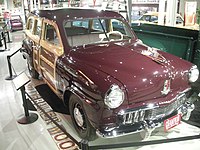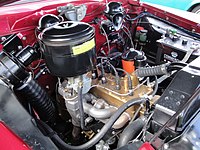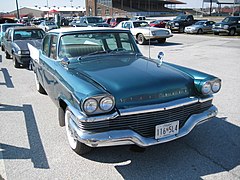
Studebaker was an American wagon and automobile manufacturer based in South Bend, Indiana, with a building at 1600 Broadway, Times Square, Midtown Manhattan, New York City. Founded in 1852 and incorporated in 1868 as the Studebaker Brothers Manufacturing Company, the firm was originally a coachbuilder, manufacturing wagons, buggies, carriages and harnesses.

The Buick Skylark is a passenger car formerly produced by Buick. The model was made in six production runs, during 46 years, over which the car's design varied dramatically due to changing technology, tastes, and new standards implemented over the years. It was named for the species of bird called skylark.

The Chevrolet Bel Air is a full-size car produced by Chevrolet for the 1950–1981 model years. Initially, only the two-door hardtops in the Chevrolet model range were designated with the Bel Air name from 1950 to 1952. With the 1953 model year, the Bel Air name was changed from a designation for a unique body shape to a premium level of trim applied across a number of body styles. The Bel Air continued with various other trim level designations, and it had gone from a mid-level trim car to a budget fleet sedan when U.S. production ceased in 1975. Production continued in Canada, for its home market only, through the 1981 model year.

The Chrysler New Yorker is an automobile model produced by Chrysler from 1940 until 1996, serving for several decades as either the brand's flagship model or as a junior sedan to the Chrysler Imperial, the latter during the years in which the Imperial name was used within the Chrysler lineup rather than as a standalone brand.

The Buick Special was an automobile produced by Buick. It was usually Buick's lowest-priced model, starting out as a full-size car in 1936 and returning in 1961 as a mid-size. The Special was built for several decades and was offered as a coupe, sedan and later as a station wagon. When GM modernized their entry level products in the 1960s, the Special introduced the modern Buick V6 that became a core engine for GM for several decades and lived on in upgraded form until 2006.

Buick Century is the model name that was used by Buick for a line of upscale full-size cars from 1936 to 1942 and 1954 to 1958, as well as from 1973 to 2005 for mid-size cars.

The Pontiac LeMans is a model name applied to automobiles marketed by Pontiac. The name came from the French city of Le Mans, the site of the 24 Hours of Le Mans, the world's oldest active sports car endurance race that began in 1923. Originally a trim upgrade package based on the Tempest, the LeMans became a separate model in 1963.

The Opel Rekord is a large family car which was built in eight generations by the German car manufacturer Opel. Between 1953 and 1986, approximately ten million were sold.

The Buick Roadmaster is an automobile that was built by Buick from 1936 until 1942, from 1946 until 1958, and then again from 1991 until 1996. Roadmasters produced between 1936 and 1958 were built on Buick's longest non-limousine wheelbase and shared their basic structure with the entry-level Cadillac Series 65, the Buick Limited, and after 1940, the Oldsmobile 98. Between 1946 and 1957 the Roadmaster served as Buick's flagship.
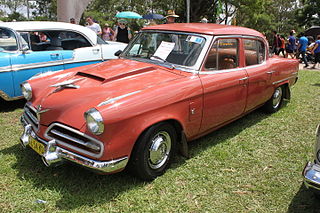
The Studebaker Land Cruiser is an automobile that was produced by the Studebaker Corporation of South Bend, Indiana from 1934–1954. The Land Cruiser debuted at the World's Fair alongside the Silver Arrow, a product of Studebaker's former premium make Pierce-Arrow. It was also manufactured in Vernon, California.

The Studebaker Commander is the model name of several automobiles produced by the Studebaker Corporation of South Bend, Indiana and Studebaker of Canada Ltd of Walkerville and, later, Hamilton, Ontario (Canada). Studebaker began using the Commander name in 1927 and, with interruptions in 1936 and 1959-63, continued to use it until 1964. The name was applied to various products in the company's line-up from year to year. The Commander was the company's mainstream product, the Studebaker Champion was the junior model, and other models were short lived or renamed as market conditions required.

The Studebaker Lark is a compact car that was produced by Studebaker from 1959 to 1966.

The Chevrolet Delray, named after the Delray neighborhood of Detroit, Michigan, debuted in 1954 as an optional trim level on two-door models of Chevrolet's mid-range 210 series of cars. In 1958, it became a distinct series of its own at the bottom of Chevrolet's lineup, and added a four-door sedan, and sedan delivery, but it only remained in production for that model year.

The Starlight coupe is a unique 2-door body style that was offered by Studebaker Corporation of South Bend, Indiana from 1947 to 1955 on its Champion and Commander model series. It was designed by Virgil Exner, formerly of Raymond Loewy Associates along the lines of the ponton style that had just gone mainstream after the WWII.
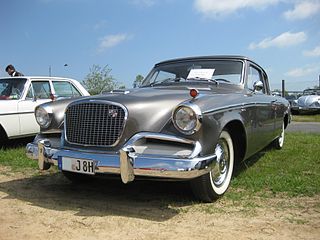
The Studebaker Flight Hawk introduced by Studebaker in 1956 was the lowest-priced model in the four-model Hawk family sports car line that included the Golden Hawk, Sky Hawk, Power Hawk, and Flight Hawk.

The Newport was a name used by Chrysler for both a hardtop body designation and also for its lowest priced model between 1961 and 1981. Chrysler first used the Newport name on a 1940 show car, of which five vehicles were produced. From 1950 to 1956, the Newport name was then used to designate any Chrysler model with a hardtop body style. In 1961, Chrysler introduced the Newport as a new, low-priced model, offering large, comfortable two- and four-door Chrysler models that were modestly priced compared with the Chrysler 300, the Chrysler New Yorker and the Imperial. For 1961, the Newport was priced below the Chrysler Windsor in the Windsor's final year.

The Hudson Wasp is an automobile built and marketed by the Hudson Motor Car Company of Detroit, Michigan, from the 1952 through the 1956 model years. After Hudson merged with Nash Motors, the Wasp was then built by American Motors Corporation in Kenosha, Wisconsin, and marketed under its Hudson marque for model years 1955 and 1956.
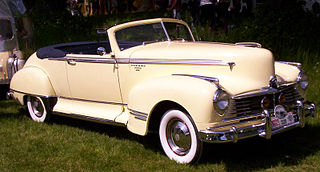
The Hudson Commodore is an automobile that was produced by the Hudson Motor Car Company of Detroit, Michigan between 1941 and 1952. During its time in production, the Commodore was the largest and most luxurious Hudson model.

The Chevrolet 210 or Two-Ten is a midrange car from Chevrolet that was marketed from 1953 until 1957. It took its name by shortening the production series number 2100 by one digit in order to capitalize on the 1950s trend toward numerical auto names. The numerical designation "210" was also sporadically used in company literature. It replaced the Styleline DeLuxe model available in previous years. The 210 was discontinued after the 1957 model year to be replaced by the Biscayne.
Pichon-Parat was a French carrosserie based in the commune of Sens, in the department of Yonne. Established in 1952, it was known for producing custom cabriolet, coupé, estate car, and shooting brake conversions of established models from major automakers, and for building their own distinctive sporting models with completely original bodywork.










